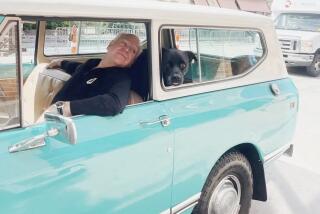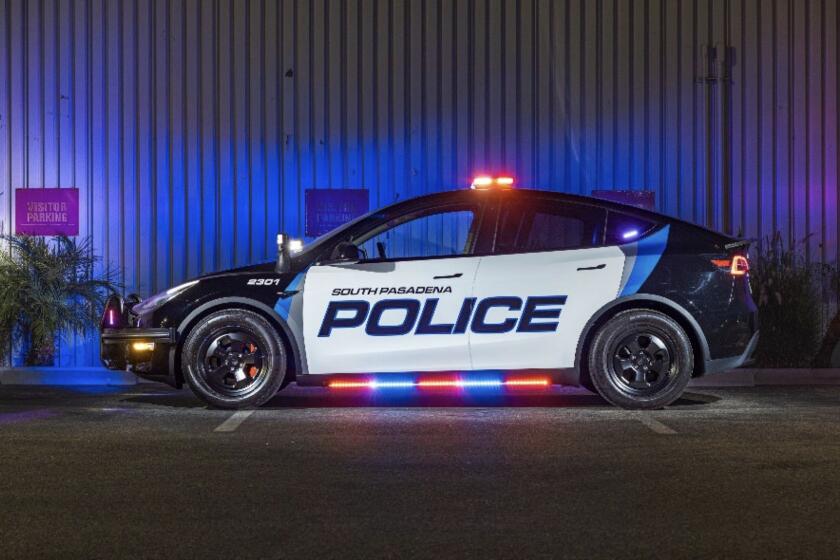Review: Cruising California canyons in Jaguar’s F-Type SVR
Jaguar Land Rover, taking a page from the European luxury car playbook, is offering increasingly attractive performance versions of its entry-level sports cars.
One of those was on display at Mazda Raceway Laguna Seca during the recent Monterey Car Week, which culminates at Pebble Beach with the famed Concours D’Elegance.
At the track, days before the Concours, Jaguar designers showed off the XE SV Project 8, a street-legal track car, in front of the raceway pits. They boasted deservedly about its good looks and great specifications — including its 592 horsepower and $187,500 sticker price. (Don’t worry. You don’t have to buy one. Jaguar will make only 300 of them.)
Another of those is the F-Type SVR, the high-performing variation on its entry-level F-Type coupe.
The 2017 F-Type SVR is the company’s answer to Aston Martin’s Vanquish S Super GT, say, or the Quadrifoglio line of Alfa Romeo Giuliettas.
Quicker, faster and better-handling than the base F-Type, the SVR model is a high-octane sports car disguised as a luxury car. (Or maybe it’s the other way around.) I spent a few hours tooling it around the Pebble Beach area, and then had an entire day to drive it from Monterey to Los Angeles.
The F-Type has become the company’s bread and butter vehicle. Currently offered in 22 configurations, mixing trim levels, engine sizes and hardtop or convertible variations, the F-Type starts at as low as $62,395 for a base Coupe with a manual transmission and climbs to $129,795 for a base SVR Convertible.
That’s the one I drove. It isn’t available with a manual transmission, and only comes in the all-wheel-drive configuration. And it’s a pip.
Built upon the same platform as the base level F-Type and the F-Type R — which we reviewed a while back — the SVR version is powered by a supercharged, 5-liter, V-8 engine that makes 575 horsepower and 516 pound-feet of torque.
It gets from zero to 60 miles per hour in a reported 3.5 seconds in a straight line, and can achieve a top speed of 200 miles per hour — slightly less in the convertible.
That’s fast for an F-Type, but that’s not the interesting part. It also cooks in the corners.
There were a lot of those on the route I chose home from Monterey, especially in the middle section of the drive. Eager to stretch the day out and pretend like I was on vacation, I took the top down and left the historic El Camino Real — a.k.a. Highway 101 — near Paso Robles, heading east on Highway 41, then taking the short twisty Highway 229 down to Highway 58.
That scenic route of rolling hills, quick turns and sudden elevation changes made the most of the SVR’s sharp electric-assist steering, tight suspension and responsive braking.
Eager to put all the SVR’s best traits to work, I shifted into Dynamic mode, which heightened performance and the delicious percolation coming from the exhaust pipes.
The car can also be placed into Track mode, which removes traction control and brings out the real beast in the SVR. An additional driving mode, marked Snow, wasn’t required for this drive, which featured triple-digit temperatures.
A rear wing helps keep the rear wheels solidly on the ground at extremely high speeds. I didn’t need that, any more than the Snow setting, but it gave credence to the company’s 200-mph top speed claims.
Unlike some equally exciting sports cars, the SVR was also a comfortable freeway flier. After I’d left the twisties and returned to the 101, I returned the drive mode to normal setting and put the top up to assess its grand touring features.
These are harder to enjoy. Even with the top up, the SVR is a noisy ride, the wind and tire noise making it difficult to appreciate the good sound system or chat comfortably on the phone.
The race-inspired seats are snug and adjustable, but are not able to lean back very far. (Are you the type of driver who sometimes likes to recline the seat and take a little nap? Not in this car.)
There’s also not a lot of room for storage. On the convertible, trunk space is limited to 7.3 cubic feet — about half what’s available on the coupe.
In practical terms, that meant it could hold one carry-on bag, tipped in sideways, and not a lot else. Was there space behind the seats for that other carry-on bag? There was not. I drove home with my second suitcase in the passenger seat.
The F-Type has become an important car for Jaguar Land Rover. Global sales for the entire JLR fleet was 583,313 units in 2016, a spokesman for the company said. Jaguar models accounted for 148,730 of those vehicles — and only about 11,000 of them were F-Types.
The SVR versions of Jaguar Land Rover vehicles represent a still smaller slice of the pie. They may draw customers eager for more power and performance, but they aren’t for everybody — or even everybody with enough wallet to afford one. The F-Type SVR’s size, limited storage and seating configuration will disqualify it for a lot of buyers.
But the car adds luster to the brand, and if you have to drive back from Pebble Beach, on a sunny day, with the top down, via Highway 229 — you could hardly pick a better way to do it.
2017 Jaguar F-Type SVR
Times’ take: Jaguar’s track car version of the F-Type
Highs: Sports car with good looks and great performance
Lows: Limited storage, noisy freeway ride
Vehicle type: Two-door, two-passenger convertible
Base price: $129,795
Price as tested: $132,283
Powertrain: 5-liter supercharged V-8 gasoline engine
Transmission: 8-speed automatic
Horsepower: 575
Torque: 516 pound-feet
EPA fuel economy rating: 15 miles per gallon city / 23 highway / 18 combined







